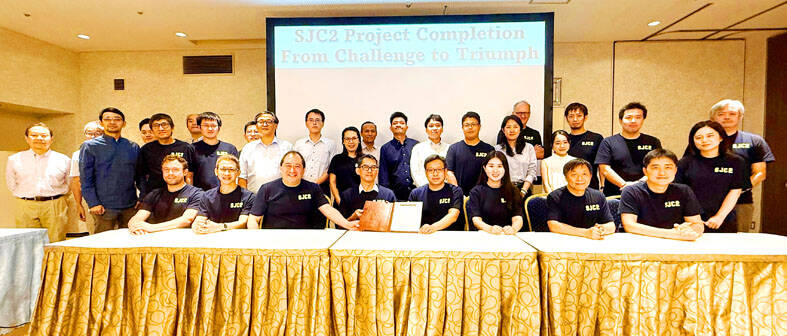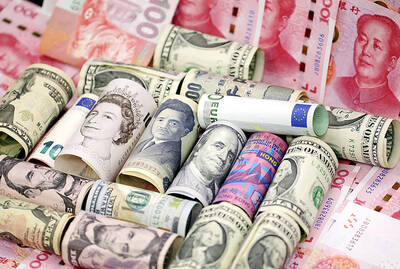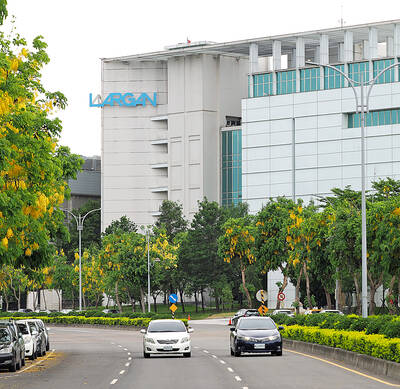Chunghwa Telecom Co (中華電信) yesterday said it has activated a new submarine cable system — the Southeast Asia–Japan Cable 2 (SJC2) — jointly with its Asian partners to satisfy growing data transmission demand and enhance its network resilience.
SJC2 spans about 10,500km, and connects key locations across Southeast and Northeast Asia, including Taiwan, Singapore, Thailand, Vietnam, Hong Kong, China, South Korea and Japan, Chunghwa Telecom said in a statement.

Photo courtesy of Chunghwa Telecom Co
TRANSMISSION CAPACITY
Built with cutting-edge optical wavelength division multiplexing technology, SJC2 delivers up to 126 terabits per second of transmission capacity, the statement said.
The company has invested NT$1.36 billion (US$46.2 million) in the project, which is part of its network enhancement plan covering undersea, land and space networks, Chunghwa Telecom chairman Chien Chih-cheng (簡志誠) said in the statement.
“Chunghwa Telecom will continue to take concrete actions to enhance the digital resilience of Taiwan’s communications network, and empower artificial intelligence to drive industry transformation and change,” Chien said.
DUAL LANDING
Taiwan features a dual landing design with cable stations in New Taipei City’s Tamsui District (淡水) and Pingtung County’s Fangshan Township (枋山), ensuring route diversity and enhancing Taiwan’s international connectivity, the company said.
The launch of SJC2 comes after the company on Wednesday inked an agreement with several overseas partners to jointly construct another submarine cable, the Asia United Gateway East Submarine Cable System.
The company is investing NT$2.4 billion in the project and expects it be to be completed in 2029, it said.

Taiwan’s foreign exchange reserves hit a record high at the end of last month, surpassing the US$600 billion mark for the first time, the central bank said yesterday. Last month, the country’s foreign exchange reserves rose US$5.51 billion from a month earlier to reach US$602.94 billion due to an increase in returns from the central bank’s portfolio management, the movement of other foreign currencies in the portfolio against the US dollar and the bank’s efforts to smooth the volatility of the New Taiwan dollar. Department of Foreign Exchange Director-General Eugene Tsai (蔡炯民)said a rate cut cycle launched by the US Federal Reserve

Handset camera lens maker Largan Precision Co (大立光) on Sunday reported a 6.71 percent year-on-year decline in revenue for the third quarter, despite revenue last month hitting the highest level in 11 months. Third-quarter revenue was NT$17.68 billion (US$581.2 million), compared with NT$18.95 billion a year earlier, the company said in a statement. The figure was in line with Yuanta Securities Investment Consulting Co’s (元大投顧) forecast of NT$17.9 billion, but missed the market consensus estimate of NT$18.97 billion. The third-quarter revenue was a 51.44 percent increase from NT$11.67 billion in the second quarter, as the quarter is usually the peak

Nvidia Corp’s major server production partner Hon Hai Precision Industry Co (鴻海精密) reported 10.99 percent year-on-year growth in quarterly sales, signaling healthy demand for artificial intelligence (AI) infrastructure. Revenue totaled NT$2.06 trillion (US$67.72 billion) in the last quarter, in line with analysts’ projections, a company statement said. On a quarterly basis, revenue was up 14.47 percent. Hon Hai’s businesses cover four primary product segments: cloud and networking, smart consumer electronics, computing, and components and other products. Last quarter, “cloud and networking products delivered strong growth, components and other products demonstrated significant growth, while smart consumer electronics and computing products slightly declined,” compared with the

The US government on Wednesday sanctioned more than two dozen companies in China, Turkey and the United Arab Emirates, including offshoots of a US chip firm, accusing the businesses of providing illicit support to Iran’s military or proxies. The US Department of Commerce included two subsidiaries of US-based chip distributor Arrow Electronics Inc (艾睿電子) on its so-called entity list published on the federal register for facilitating purchases by Iran’s proxies of US tech. Arrow spokesman John Hourigan said that the subsidiaries have been operating in full compliance with US export control regulations and his company is discussing with the US Bureau of